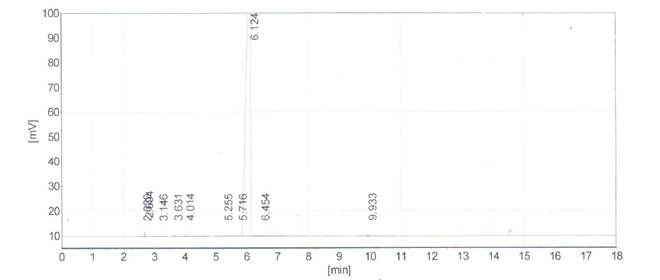Hexanal CAS#: 66-25-1; ChemWhat Code: 74688
| Names & Identifiers | New Literature | Spectral Properties |
| Chemical & Physical Properties | New Patents | Market Information |
| Safety & Hazards | Transportation, Storage & Usage | Approved Manufacturers |
Names & Identifiers
| Product Name | Hexanal |
| Molecular Structure | |
| CAS Registry Number | 66-25-1 |
| EINECS Number | 200-624-5 |
| Synonyms | 1-Hexanal;1-Hexylaldehyde;66-25-1 [RN];Capronic Aldehyde;hexanal [Portuguese] [ACD/IUPAC Name] [ACD/Index Name];Hexanal [ACD/IUPAC Name] [ACD/Index Name];Hexanal [German] [ACD/IUPAC Name] [ACD/Index Name];Hexanal [French] [ACD/IUPAC Name] [ACD/Index Name];[66-25-1];1-Formylpentane;1-Pentanecarbaldehyde;200-624-5 [EINECS];4-01-00-03296 (Beilstein HandbookReference) [Beilstein];Aldehyde C6;Aldehyde C-6;C6 aldehyde;Caproaldehyde;Caproic aldehyde;CAPROIC ALDEHYDE with GC;Capronaldehyde;EINECS 200-624-5;hexaldehyde;Hexan-1-al;Hexanal (Capronaldehyde);HEXANAL-D12;hexanaldehyde;hexane-1-oxide;Hexoic aldehyde;Hexyl aldehyde;Hexylaldehyde;Kapronaldehyd [Czech];Kapronaldehyd [Czech];MFCD00007027 [MDL number];MN7175000;n-C5H11CHO [Formula];n-Caproaldehyde;n-Caproic aldehyde;n-Capronaldehyde;n-Caproylaldehyde;nchembio882-comp4;n-Hexaldehyde;n-hexanal;N-Hexylaldehyde;UN 1207;UNII:9DC2K31JJQ;UNII-9DC2K31JJQ;VH5 [WLN];WLN: VH5 |
| MDL Number | MFCD00007027 |
| Beilstein Registry Number | 506198 |
| Molecular Formula | C6H12O |
| Molecular Weight | 100.159 |
| SMILES | CCCCCC=O |
| Std. InChi | InChI=1S/C6H12O/c1-2-3-4-5-6-7/h6H,2-5H2,1H3 |
| Std. InChIKey | JARKCYVAAOWBJS-UHFFFAOYSA-N |
Chemical & Physical Properties
| Appearance | Colorless liquid |
| Odor | Grease and grass scent |
| Specific Gravity(25/25℃) | 0.790-0.870g/cm3 |
| Vapor Density | >1 (vs air) |
| Vapor Pressure | 10 mmHg ( 20 °C) |
| Boiling Point | 130-131 °C(lit.) |
| Melting Point | < -19.99 °C (< -3.98 °F) |
| Flash Point | 25 °C (77 °F) – closed cup |
| Ignition temperature | 204 °C (399 °F) |
| Lower explosion limit | 1 %(V) |
| Upper explosion limit | 7.5 %(V) |
| Vapour pressure | 13 hPa (10 mmHg) at 25 °C (77 °F) |
| Partition coefficient: n-octanol/water | log Pow: 1.78 |
| Relative vapour density | 3.46-(Air = 1.0) |
| Refractive Index | n20/D 1.4035(lit.) |
| Density | 0.815 g/mL at 25 °C(lit.) |
| 0.834 g/mL at 25 °C |
Safety & Hazards
| Symbol |  Irritant Irritant Flame Flame |
| Signal | Warning |
| Personal Protective Equipment | Eyeshields, Faceshields, full-face respirator (US), Gloves, multi-purpose combination respirator cartridge (US), type ABEK (EN14387) respirator filter |
| GHS Hazard Statements | H226 (100%): Flammable liquid and vapor [Warning Flammable liquids] H319 (99.73%): Causes serious eye irritation [Warning Serious eye damage/eye irritation] Information may vary between notifications depending on impurities, additives, and other factors. The percentage value in parenthesis indicates the notified classification ratio from companies that provide hazard codes. Only hazard codes with percentage values above 10% are shown. (The corresponding statement to each H-code can be found here.) |
| Precautionary Statement Codes | P210, P233, P240, P241, P242, P243, P264, P280, P303+P361+P353, P305+P351+P338, P337+P313, P370+P378, P403+P235, and P501 (The corresponding statement to each P-code can be found here.) |
| Toxicity | Acute toxicity Oral LD50 LD50 Oral – Rat – 4,890 mg/kg Dermal LD50 LD50 Dermal – Rabbit – 5,500 mg/kg Serious eye damage/eye irritation Eyes – Rabbit – Moderate eye irritation Germ cell mutagenicity Genotoxicity in vitro – Hamster – Lungs Mutation in mammalian somatic cells. Genotoxicity in vitro – Rat – Liver Unscheduled DNA synthesis Carcinogenicity IARC: No component of this product present at levels greater than or equal to 0.1% is identified as probable, possible or confirmed human carcinogen by IARC. ACGIH: No component of this product present at levels greater than or equal to 0.1% is identified as a carcinogen or potential carcinogen by ACGIH. Potential health effects Inhalation May be harmful if inhaled. May cause respiratory tract irritation. Ingestion May be harmful if swallowed. Skin May be harmful if absorbed through skin. May cause skin irritation. Eyes May cause eye irritation. Signs and Symptoms of Exposure To the best of our knowledge, the chemical, physical, and toxicological properties have not been thoroughly investigated. |
| Transportation Information | ADR/RID: Proper shipping name: Hexaldehyde;Class 3; Packaging Group: III; UN Number: 1207 IMDG: Proper shipping name: Hexaldehyde;Class 3; Packaging Group: III; UN Number: 1207 IATA: Proper shipping name: Hexaldehyde;Class 3; Packaging Group: III; UN Number: 1207 |
| WGK Germany | 1 |
| RTECS | MN7175000 |
New Literature
[table id=51/]
New Patents
[table id=52/]
Transportation, Storage & Usage
| Transportation | Under the room temperature and away from light |
| HS Code | 290621 |
| Storage | Under the room temperature and away from light |
| Shelf Life | 2 years |
| Application | Hexanal has been used in the quantification of carbonyls that contribute to the complex flavor of olive oil. It can also be used for Wittig and aldol reactions. |
| General Description | Hexanal is present in lactoperoxidase-bleached WPC80 (whey protein concentrate with 80% protein). |
Spectral Properties
| GC of Hexanal CAS#: 66-25-1 |  |
Market Information
| Reference Price(The average price based on Chemwhat’s market research) | USD 43/kg |
Buy Reagent | |
| No reagent supplier? | Send quick inquiry to ChemWhat |
| Want to be listed here as a reagent supplier? (Paid service) | Click here to contact ChemWhat |
Approved Manufacturers | |
| Ulcho Biochemical Ltd | https://www.ulcho.com/ |
| Want to be listed as an approved manufacturer (Requires approvement)? | Please download and fill out this form and send back to approved-manufacturers@chemwhat.com |
Other Suppliers | |
| Watson International Limited | Visit Watson Official Website |
Contact Us for Other Help | |
| Contact us for other information or services | Click here to contact ChemWhat |

